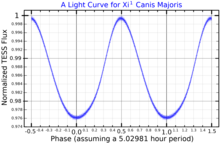Xi1Canis Majoris
| Observation data EpochJ2000.0EquinoxJ2000.0 | |
|---|---|
| Constellation | Canis Major |
| Right ascension | 06h31m51.36636s[1] |
| Declination | −23° 25′ 06.3181″[1] |
| Apparent magnitude(V) | 4.33 – 4.36[2] |
| Characteristics | |
| Spectral type | B1 III[3] |
| U−Bcolor index | −0.98[4] |
| B−Vcolor index | −0.24[4] |
| Variable type | β Cep[3] |
| Astrometry | |
| Radial velocity(Rv) | +26.9[5]km/s |
| Proper motion(μ) | RA:−2.91[1]mas/yr Dec.:+6.22[1]mas/yr |
| Parallax(π) | 2.36 ± 0.20mas[1] |
| Distance | 1,400 ± 100ly (420 ± 40pc) |
| Absolute magnitude(MV) | −3.86[6] |
| Details | |
| Mass | 14.2±0.4[6]M☉ |
| Radius | 7.9±0.6[6]R☉ |
| Luminosity | 30,900+8,900 −6,900[6]L☉ |
| Surface gravity(logg) | 3.78±0.07[6]cgs |
| Temperature | 27,000±1,000[6]K |
| Metallicity[Fe/H] | −0.18[7]dex |
| Rotational velocity(vsini) | 0[6]km/s |
| Age | 11.1±0.7[6]Myr |
| Other designations | |
| Database references | |
| SIMBAD | data |
Xi1Canis Majoris,Latinizedfrom ξ1Canis Majoris, is aBeta Cephei variablestarin theconstellationCanis Major.It is approximately 1,400light yearsfromEarth.
ξ1Canis Majoris is a blue-whiteB-typestar. It has generally been assigned aluminosity classof III (giant) or IV (subgiant), for example B1III[3]or B0.5IV.[6]Comparison of its properties with modelevolutionary trackssuggest that it is amain sequencestar about three quarters of the way through its main sequence lifetime.[6]

Theapparent magnitudevaries from +4.33 to +4.36 with a period of 5.03 hours.[2]Its pulsations cause its radius to vary by 1.0% to 1.5%. At the same time itseffective temperatureby about500Kabove and below its mean temperature.[6]
ξ1Canis Majoris has the longest known rotation period of any B class star, taking around 30 years to complete one revolution on its axis.[9]This is thought to be due tomagnetic braking;ξ1Canis Majoris has the strongest magnetic field of any β Cephei star and would be expected to spin down completely in around four million years. It also has the strongest and hardestX-rayemission of any β Cephei star.[6]
ξ1Canis Majoris forms a naked eye pairing withξ2Canis Majorisa little less than a degree away. TheWashington Double Star Cataloglists two 14th magnitude companions about27″away.[10]In addition, an unseen close companion is suspected due to some faintemission linesin the spectrum that are best explained by aBe starinvisible against the brighter primary.[6]
References[edit]
- ^abcdevan Leeuwen, F. (2007). "Validation of the new Hipparcos reduction".Astronomy and Astrophysics.474(2): 653–664.arXiv:0708.1752.Bibcode:2007A&A...474..653V.doi:10.1051/0004-6361:20078357.S2CID18759600.
- ^ab"International Variable Star Index".Retrieved2018-11-13.
- ^abcHubrig, S.; et al. (January 2009). "New magnetic field measurements of beta Cephei stars and Slowly Pulsating B stars".Astronomische Nachrichten.330(4): 317.arXiv:0902.1314.Bibcode:2009AN....330..317H.doi:10.1002/asna.200811187.S2CID17497112.
- ^abJohnson, H. L.; et al. (1966). "UBVRIJKL photometry of the bright stars".Communications of the Lunar and Planetary Laboratory.4(99): 99.Bibcode:1966CoLPL...4...99J.
- ^Evans, D. S. (June 20–24, 1966). "The Revision of the General Catalogue of Radial Velocities". In Batten, Alan Henry; Heard, John Frederick (eds.).Determination of Radial Velocities and their Applications, Proceedings from IAU Symposium no. 30.Determination of Radial Velocities and Their Applications.Vol. 30. p. 57.Bibcode:1967IAUS...30...57E.
- ^abcdefghijklmShultz, M.; Wade, G. A.; Rivinius, Th.; Neiner, C.; Henrichs, H.; Marcolino, W.; MiMeS Collaboration (2017)."The pulsating magnetosphere of the extremely slowly rotating magnetic β Cep star ξ1CMa ".Monthly Notices of the Royal Astronomical Society.471(2): 2286.arXiv:1706.08820.Bibcode:2017MNRAS.471.2286S.doi:10.1093/mnras/stx1632.
- ^Anderson, E.; Francis, Ch. (2012). "XHIP: An extended hipparcos compilation".Astronomy Letters.38(5): 331.arXiv:1108.4971.Bibcode:2012AstL...38..331A.doi:10.1134/S1063773712050015.S2CID119257644.
- ^"MAST: Barbara A. Mikulski Archive for Space Telescopes".Space Telescope Science Institute.Retrieved20 August2022.
- ^Shultz, M.; Kochukhov, O.; Wade, G. A.; Rivinius, Th (2018). "The pulsationally modulated radial crossover signature of the slowly rotating magnetic B-type star ξ1CMa ".Monthly Notices of the Royal Astronomical Society.478(1): L39.arXiv:1804.07535.Bibcode:2018MNRAS.478L..39S.doi:10.1093/mnrasl/sly070.
- ^Mason, Brian D.; Wycoff, Gary L.; Hartkopf, William I.; Douglass, Geoffrey G.; Worley, Charles E. (2001)."The 2001 US Naval Observatory Double Star CD-ROM. I. The Washington Double Star Catalog".The Astronomical Journal.122(6): 3466.Bibcode:2001AJ....122.3466M.doi:10.1086/323920.

